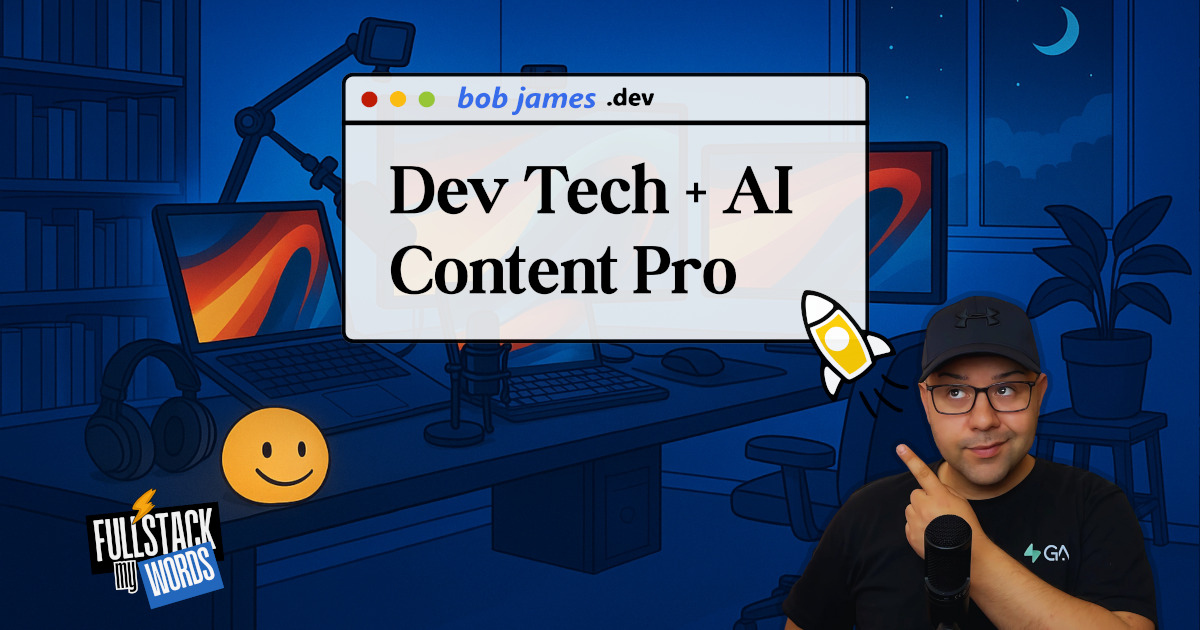Building Modern Web Applications
How modern web development is faster, smarter, and easier than ever before.

Web development in 2025 is unrecognizable from just five years ago.
While many developers are still building apps with 2020 techniques, the smart ones have moved to AI-powered workflows, serverless architectures, and frameworks that handle complexity automatically.
If you're still manually configuring webpack, writing boilerplate code by hand, or deploying through FTP, you're not just behind - you're using tools from a different era.
👉 Here's how to build web applications the modern way.
What You'll Learn About Modern Web Development 🚀
This isn't just a framework comparison - it's a complete guide to building web applications that can compete in 2025.
You'll master:
- The Modern Stack: Which technologies actually matter and why
- Framework Selection: Choosing the right tools for your specific needs
- AI Integration: How to leverage AI throughout your development process
- Performance by Default: Building fast applications without manual optimization
- Deployment Revolution: From code to production in minutes, not hours
- Developer Experience: Tools that make coding enjoyable rather than frustrating
By the end of this guide, you'll understand not just what to build with, but how to build web applications that users love and developers can maintain.
Ready to modernize your web development? 💻
The Reality Check: Why Old Approaches Don't Work
Before diving into modern solutions, let's understand why traditional web development approaches are holding you back.
If you're still building web apps like it's 2020, you're dealing with:
- Manual bundling and build configuration
- Server management and scaling headaches
- Slow development cycles with lengthy deployments
- Performance problems that require expert optimization
- Security vulnerabilities you have to prevent manually
Modern web development solves all of these problems automatically.
The Modern Web Development Stack
Today's web applications are built on a foundation of tools that prioritize developer productivity and user experience.
The Frontend Revolution
React/Next.js: The dominant force in modern web development
- Component-based architecture that scales
- Server-side rendering for performance
- Automatic code splitting and optimization
- Rich ecosystem and community support
TypeScript: JavaScript with superpowers
- Catch errors before they reach production
- Better code completion and refactoring
- Self-documenting code through types
- Seamless integration with modern frameworks
Tailwind CSS: Utility-first styling
- Consistent design systems built-in
- No more CSS naming conflicts
- Responsive design by default
- Faster development with utility classes
The Backend Evolution
Serverless Functions: Code without server management
- Automatic scaling based on demand
- Pay only for actual usage
- No server maintenance or security updates
- Global edge deployment automatically
Database as a Service: Data management simplified
- Supabase: PostgreSQL with real-time subscriptions
- PlanetScale: MySQL with branching and schema management
- MongoDB Atlas: NoSQL with built-in search and analytics
- Automatic backups, scaling, and security
API Integration: Services that talk to each other
- GraphQL for efficient data fetching
- REST APIs with automatic documentation
- Real-time updates through WebSockets
- Third-party service integration made simple
Framework Selection: Choosing Your Weapons
Not all frameworks are created equal. Here's how to choose the right tools for your specific needs.
For Content-Heavy Applications
Next.js with App Router
- Static site generation for blazing speed
- SEO optimization built-in
- Image optimization automatic
- Perfect for blogs, marketing sites, documentation
When to choose Next.js:
- Content that needs to rank in search engines
- Applications with mostly static content
- Teams that want React with server-side capabilities
- Projects requiring maximum performance
For Interactive Applications
React with Vite
- Lightning-fast development server
- Hot module replacement that actually works
- Modern JavaScript features out of the box
- Smaller bundle sizes than traditional tools
When to choose React + Vite:
- Complex user interfaces with lots of interactivity
- Applications that don't require server-side rendering
- Teams that want maximum flexibility
- Projects prioritizing development speed
For Full-Stack Applications
T3 Stack (Next.js + TypeScript + tRPC + Prisma)
- End-to-end type safety from database to UI
- Automatic API generation from database schema
- Built-in authentication and authorization
- Developer experience optimized for productivity
When to choose T3 Stack:
- Applications requiring complex data relationships
- Teams that prioritize type safety
- Projects with both frontend and backend requirements
- Rapid prototyping with production-ready code
For Real-Time Applications
Next.js + Supabase
- Real-time data synchronization
- Built-in authentication with social providers
- PostgreSQL with automatic scaling
- Edge functions for custom backend logic
When to choose Next.js + Supabase:
- Chat applications or collaborative tools
- Applications requiring user authentication
- Projects needing real-time data updates
- Teams wanting backend-as-a-service simplicity
AI Integration: The Game Changer
AI isn't just changing how we write code - it's transforming how we build entire applications.
AI-Powered Development Workflow
GitHub Copilot + VS Code
- Code completion that understands context
- Automatic test generation
- Documentation writing assistance
- Bug detection and fixing suggestions
Claude Code for Architecture
- Codebase analysis and improvement suggestions
- Refactoring large applications safely
- Security vulnerability identification
- Performance optimization recommendations
AI in Production Applications
OpenAI API Integration
- Natural language processing in your apps
- Content generation and summarization
- Intelligent search and recommendations
- Automated customer support
Vercel AI SDK
- Streaming AI responses for better UX
- Built-in rate limiting and error handling
- Type-safe AI function calling
- Edge runtime optimization for speed
AI-Enhanced User Experiences
Smart Components
- Forms that adapt based on user input
- Search that understands intent, not just keywords
- Content personalization without tracking
- Accessibility improvements through AI analysis
Example: AI-Powered Search Component
import { generateText } from 'ai'
export async function intelligentSearch(query: string) {
const enhancedQuery = await generateText({
model: openai('gpt-4'),
prompt: `Transform this search query into semantic search terms: ${query}`
})
return searchDatabase(enhancedQuery)
}Performance by Default: Speed Without Effort
Modern web development frameworks handle performance optimization automatically.
Automatic Optimizations
Next.js Performance Features:
- Image optimization with WebP/AVIF conversion
- Font optimization with automatic subsetting
- Code splitting at the page and component level
- Static generation with incremental regeneration
Vite Performance Features:
- Native ES modules for faster development
- Tree shaking to eliminate unused code
- Automatic CSS code splitting
- Optimized production builds with Rollup
Database Performance
Modern Database Strategies:
- Connection pooling handled automatically
- Query optimization through ORMs
- Caching layers built into database services
- CDN integration for static assets
Example: Optimized Data Fetching
// Automatic caching and revalidation
export async function getStaticProps() {
const data = await fetch('https://api.example.com/data', {
next: { revalidate: 3600 } // Cache for 1 hour
})
return { props: { data } }
}Edge Computing
Vercel Edge Functions:
- Code runs closer to users globally
- Automatic scaling based on demand
- Sub-100ms response times worldwide
- No cold start delays
Cloudflare Workers:
- JavaScript running on Cloudflare's global network
- Instant deployment to 200+ locations
- Built-in caching and performance optimization
- Database connectivity from the edge
The Deployment Revolution
Gone are the days of FTP uploads and server configuration. Modern deployment is magical.
Continuous Deployment
Git-Based Deployment:
- Push code to GitHub
- Automatic build and testing
- Deploy to global CDN
- Database migrations run automatically
- DNS updates propagate worldwide
Zero-downtime deployments with automatic rollbacks if anything goes wrong.
Platform Comparison
Vercel (Best for Next.js)
- Automatic HTTPS and CDN
- Branch previews for every pull request
- Built-in analytics and performance monitoring
- Serverless functions deployment
Netlify (Best for Static Sites)
- Form handling without backend code
- Split testing built-in
- Automatic image optimization
- Plugin ecosystem for extended functionality
Railway (Best for Full-Stack Apps)
- Database hosting included
- Automatic scaling based on traffic
- Branch-based development environments
- One-click deployments for popular frameworks
Database Deployment
Modern Database Hosting:
- PlanetScale: MySQL with branching like Git
- Supabase: PostgreSQL with real-time features
- MongoDB Atlas: NoSQL with built-in search
- FaunaDB: Serverless with global consistency
Key features:
- Automatic backups and point-in-time recovery
- Connection pooling and query optimization
- Built-in security and compliance
- Global replication for low latency
Developer Experience: Making Coding Enjoyable
Modern web development prioritizes developer happiness alongside user experience.
Development Environment
VS Code Extensions:
- ES7+ React/Redux/React-Native snippets: Faster component creation
- Auto Rename Tag: Automatic HTML/JSX tag updates
- Prettier: Consistent code formatting
- GitLens: Git history and blame annotations
Hot Module Replacement:
- Changes appear instantly in the browser
- State preservation during development
- No more manual page refreshes
- CSS updates without losing JavaScript state
Type Safety
End-to-End Type Safety:
// Database schema automatically generates TypeScript types
type User = {
id: string
email: string
createdAt: Date
}
// API routes are type-safe
export async function GET(): Promise<User[]> {
return await db.user.findMany()
}
// Frontend components get automatic type checking
export function UserList({ users }: { users: User[] }) {
return (
<div>
{users.map(user => (
<div key={user.id}>{user.email}</div>
))}
</div>
)
}Error Handling
Development Error Messages:
- Clear, actionable error descriptions
- Suggestions for fixing common mistakes
- Stack traces that point to your code, not framework internals
- Integration with AI tools for error explanation
Production Error Tracking:
- Sentry: Automatic error capture and context
- LogRocket: Session replay for debugging
- Vercel Analytics: Performance monitoring
- PostHog: User behavior analysis
Security in Modern Web Applications
Security is built into modern frameworks rather than bolted on afterward.
Authentication Made Simple
NextAuth.js Integration:
import NextAuth from 'next-auth'
import GoogleProvider from 'next-auth/providers/google'
export default NextAuth({
providers: [
GoogleProvider({
clientId: process.env.GOOGLE_CLIENT_ID,
clientSecret: process.env.GOOGLE_CLIENT_SECRET,
})
],
// Automatic CSRF protection, secure cookies, JWT handling
})Supabase Authentication:
- Social login with 20+ providers
- Row-level security policies
- Automatic email verification
- Multi-factor authentication support
Built-In Security Features
Next.js Security:
- Automatic CSRF protection
- XSS protection through JSX
- Content Security Policy headers
- Secure cookie handling
Database Security:
- Connection string encryption
- Automatic SQL injection prevention
- Role-based access control
- Audit logging for compliance
Real-World Application Architecture
Here's how these technologies come together in actual applications.
E-Commerce Application Stack
Frontend: Next.js with TypeScript and Tailwind CSS Backend: Serverless functions on Vercel Database: PlanetScale MySQL with Prisma ORM Payments: Stripe with webhook handling Authentication: NextAuth.js with Google/Facebook Search: Algolia with InstantSearch Analytics: Vercel Analytics + PostHog
Why this stack works:
- Automatic scaling during traffic spikes
- Global performance through CDN
- Type safety prevents runtime errors
- Built-in security for payment processing
SaaS Application Architecture
Frontend: React with Vite and TypeScript Backend: T3 stack (Next.js API routes + tRPC) Database: Supabase PostgreSQL with real-time Authentication: Supabase Auth with RLS File Storage: Supabase Storage with CDN Email: Resend for transactional emails Monitoring: Sentry for error tracking
Benefits:
- Real-time collaboration features
- Secure multi-tenant architecture
- Automatic database backups
- Built-in user management
Migration Strategies: Moving from Legacy
If you're working with older applications, here's how to modernize incrementally.
The Gradual Approach
Phase 1: Development Environment
- Add TypeScript to existing JavaScript
- Implement modern build tools (Vite/Next.js)
- Add AI coding assistants
- Set up automated testing
Phase 2: Architecture Updates
- Extract components into reusable modules
- Implement proper state management
- Add type safety to API endpoints
- Modernize styling with Tailwind CSS
Phase 3: Infrastructure
- Move to serverless deployment
- Implement proper CI/CD pipelines
- Add monitoring and error tracking
- Optimize performance with modern techniques
The Complete Rewrite Approach
When to consider a rewrite:
- Legacy code is unmaintainable
- Performance problems can't be fixed incrementally
- Security vulnerabilities are systemic
- Business requirements have completely changed
Rewrite strategy:
- Build new application alongside old one
- Migrate users gradually through feature flags
- Maintain data synchronization during transition
- Switch DNS once new application is proven
Common Pitfalls and How to Avoid Them
Even with modern tools, developers still make predictable mistakes.
Over-Engineering
The Problem: Using complex solutions for simple problems The Solution: Start simple, add complexity only when needed
Example:
// Over-engineered
class StateManager {
private state = new Map()
private listeners = new Set()
setState(key: string, value: any) {
this.state.set(key, value)
this.notifyListeners()
}
}
// Simple and effective
const [count, setCount] = useState(0)Framework Chasing
The Problem: Constantly switching to the newest framework The Solution: Choose mature, stable tools and stick with them
Decision framework:
- Does this solve a real problem I have?
- Is this framework likely to be maintained long-term?
- Does my team have the expertise to use this effectively?
- Will this actually improve our productivity?
Ignoring Performance
The Problem: Assuming modern frameworks make performance automatic The Solution: Measure, optimize, and monitor continuously
Performance checklist:
- Use Next.js Image component for automatic optimization
- Implement proper loading states and error boundaries
- Monitor Core Web Vitals in production
- Use React DevTools to identify unnecessary re-renders
The Future of Web Development
Based on current trends, here's where web development is heading.
The Next 2 Years
AI-Native Development:
- AI generates entire components from descriptions
- Automatic performance optimization through AI analysis
- Bug detection and fixing before deployment
- User experience optimization through AI insights
Edge-First Architecture:
- More computation moving to edge servers
- Database queries optimized for global distribution
- Real-time applications with sub-50ms latency
- AI running on edge for instant responses
The Next 5 Years
Intent-Based Development:
- Describe what you want, AI builds it
- Automatic accessibility compliance
- Performance optimization without manual intervention
- Security vulnerabilities prevented by AI review
Web Assembly Mainstream:
- High-performance applications in the browser
- Desktop-class applications delivered via web
- Cross-platform development through WASM
- New programming languages targeting the web
Your Modern Web Development Action Plan
Ready to modernize your web development approach? Here's your step-by-step plan.
Week 1: Foundation Setup
- Choose Your Stack: Pick Next.js or React + Vite based on your needs
- Set Up TypeScript: Add type safety from the beginning
- Install AI Tools: GitHub Copilot or equivalent for productivity
- Configure Deployment: Set up Vercel or Netlify for automatic deployment
Week 2-4: Build Your First Modern App
- Create a Simple Project: Todo app or blog to learn the tools
- Add a Database: Connect to Supabase or PlanetScale
- Implement Authentication: Use NextAuth.js or Supabase Auth
- Deploy to Production: Get comfortable with the deployment process
Month 2+: Advanced Features
- Add AI Features: Integrate OpenAI API for smart functionality
- Optimize Performance: Implement caching and optimization strategies
- Add Monitoring: Set up error tracking and analytics
- Scale Your Application: Learn about load balancing and database optimization
The Bottom Line: Modern Web Development Is Better
Web development in 2025 is faster, more secure, and more enjoyable than ever before.
Modern tools solve the problems that used to waste weeks:
- No more webpack configuration nightmares
- No more server management headaches
- No more manual performance optimization
- No more security vulnerabilities from outdated dependencies
But the biggest advantage is productivity. What used to take months now takes weeks. What used to require teams of specialists can be built by individual developers.
The catch? You have to learn new tools and abandon old habits.
The developers who embrace modern web development techniques aren't just more productive - they're building applications that users love and businesses depend on.
Ready to Build Modern Web Applications?
The tools exist today to build web applications that would have seemed impossible just five years ago.
You can create applications that:
- Scale automatically to millions of users
- Deploy globally in minutes
- Adapt intelligently to user behavior
- Maintain themselves through AI monitoring
- Provide experiences that feel magical to users
The question isn't whether you should modernize your web development approach.
It's whether you'll do it before or after your competitors gain an insurmountable advantage.
What will you build with the tools of today? The possibilities are limited only by your imagination and your willingness to embrace the future of web development. 🚀
Comments
Please sign in to leave a comment.
I can relate to this journey so much. Getting back into coding after a break is humbling but rewarding.
Recommended Articles

PowerShell Commands for Checking Windows Executable Properties
No excerpt available

React Hooks: A Complete Guide to Modern State Management
Learn everything you need to know about React Hooks, from the basics of useState and useEffect to creating powerful custom hooks. This comprehensive guide includes real-world examples and best practices for modern React development.